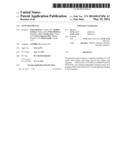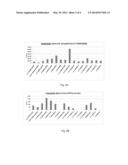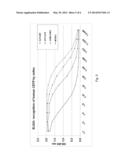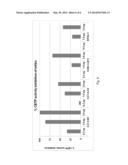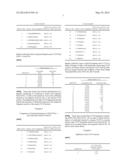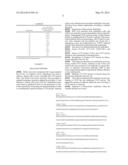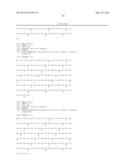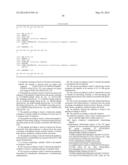Patent application title: CETP FRAGMENTS
Inventors:
Sylvia Brunner (Vienna, AT)
Mathias Gebhart (Vienna, AT)
Erika Bilcikova (Bratislava, SK)
Claudia Juno (Vienna, AT)
Pola Linzmayer-Hirt (Wiener Neudorf, AT)
Birgit Schuh (Vienna, AT)
Assignees:
AFFIRIS AG
IPC8 Class: AC07K1447FI
USPC Class:
4241851
Class name: Drug, bio-affecting and body treating compositions antigen, epitope, or other immunospecific immunoeffector (e.g., immunospecific vaccine, immunospecific stimulator of cell-mediated immunity, immunospecific tolerogen, immunospecific immunosuppressor, etc.) amino acid sequence disclosed in whole or in part; or conjugate, complex, or fusion protein or fusion polypeptide including the same
Publication date: 2014-05-29
Patent application number: 20140147456
Abstract:
The present invention relates to a peptide consisting of 6 to 20 amino
acid residues and being derived from amino acid sequence
VFKGTLKYGYTTAWWLGIDQSIDFEIDSAI (SEQ ID No. 23), wherein said peptide
comprises amino acid sequence WWLGID (SEQ ID No. 24) and antibodies
binding to these peptides.Claims:
1. A peptide consisting of from 6 to 20 amino acid residues, wherein the
peptide is derived from an amino acid sequence
VFKGTLKYGYTTAWWLGIDQSIDFEIDSAI (SEQ ID No. 23), and comprises an amino
acid sequence WWLGID (SEQ ID No. 24).
2. The peptide according to claim 1, wherein an amino acid sequence of the peptide is selected from the group consisting of YTTAWWLGIDQS (SEQ ID No. 1), YGYTTAWWLGIDQSID (SEQ ID No. 7), TTAWWLGIDQS (SEQ ID No. 8), TAWWLGIDQS (SEQ ID No. 9), AWWLGIDQS (SEQ ID No. 10), WWLGIDQS (SEQ ID No. 11), YTTAWWLGIDQ (SEQ ID No. 13), YTTAWWLGID (SEQ ID No. 14), TTAWWLGIDQ (SEQ ID No. 18), and TTAWWLGID (SEQ ID No. 19).
3. The peptide according to claim 1, wherein the peptide comprises a cysteine residue at a terminus of at least one of a C-terminus and a N-terminus.
4. The peptide according to claim 1, wherein the peptide is suitable for preventing, treating, or both preventing and treating atherosclerosis and a disease associated with atherosclerosis.
5. The peptide according to claim 4, wherein the disease associated with atherosclerosis is selected from the group consisting of peripheral arterial occlusive disease, coronary heart disease, apoplectic cerebral insultus and stroke.
6. The peptide according to claim 4, wherein the peptide is administered to an individual in an amount of from 0.5 to 500 μg per immunization.
7. A vaccine comprising a peptide, which is the peptide according to claim 1.
8. The vaccine according to claim 7, wherein the peptide is coupled or fused to a pharmaceutically acceptable carrier.
9. The vaccine according to claim 7, wherein the peptide is formulated for intradermal, subcutaneous or intramuscular administration.
10. The vaccine according to claim 7, wherein the peptide is formulated with an adjuvant.
11. The vaccine according to claim 7, wherein the vaccine comprises the peptide in an amount of 0.5 to 500 μg per immunization.
12. The vaccine according to claim 7, wherein the vaccine is suitable for preventing, treating, or both preventing and treating atherosclerosis and a disease associated with atherosclerosis.
13. The vaccine according to claim 12, wherein the disease associated with atherosclerosis is selected from the group consisting of peripheral arterial occlusive disease, coronary heart disease, apoplectic cerebral insultus and stroke.
14. An antibody, wherein the antibody is bound to the peptide according to claim 1.
15. The antibody according to claim 14, wherein: the antibody comprises a heavy chain variable region VH and an antibody light chain variable region VL, each region comprises complementary determining regions, complementary determining regions of the VH region comprise at least one amino acid sequence selected from the group consisting of NVQLQESGPGLVKPSQSLSLTCTVTGHSITSDYAWNWIRQFPGNKLEWMGYITNSGSTTYNPSLKSRISITRD- TSKNQFFLQLNSVTTEDTATYYCTRGGPYWGQGTLVTVSA (SEQ ID No. 104), EVQLVESGGGLVEPGGSLKLSCVASGFTFSTYAMSWFRLTPERRLEWVAAISNGGSQNSYPDSVKGRFTVSRD- NAKNTLYLQMSSLRSEDTAMYYCSRNGNYFDYWGQGTTLTVSS (SEQ ID No. 105), DVQLQESGPGLVKPSQSLSLTCTVTGYSITSDYAWNWIRQFPGNKLEWMGYISYSGTTTYNPSLKSRISITRH- TSKNQFFLQLNSVTTEDSATYYCTRLGYYFDYWGQGTTLTVSS (SEQ ID No. 106), and QIQLVQSGPELKKPGETVKISCKASGYTFTDCSMHWVKQAPGQGLKWMGWINTKTGEPTYADDFKGRFAFSLE- TSASTAYLQINILKNEDSATYFCAAHSGKDYAIDYWGQGTSVTVSS (SEQ ID No. 107), and complementary determining regions of the VL region comprise at least one amino acid sequence selected from the group consisting of DIVMTQSQKFMSTSVGDRVSITCKASQNVGTAVVWYQQKPGQSPKLLIYSASNRYTGVPDRFTGSGSGTDFTL- TITNMQSEDLADYFCQQYSSYPLTFGAGTKLELK (SEQ ID No 108), QIVLTQSPAIMSASPGEKVTMTCSASSSISYMHWYQQKPGTSPKRWIFDTSKLASGVPARFSGSGSGTSYSLT- ISSMEAEDAATYYCHQRSSYPTFGSGTKLEIK (SEQ ID No. 109), DIVMTQSPASLAMSVGQKVTMNCKSSQSLLSSKNQKNFLAWYQQKPGQSPKVLVYFASTRASGVPDRFIGSGS- GTDFTLTISSVQAEDLADYFCQQQYNTPLTFGAGTKLELK (SEQ ID No. 110), and DVLMTQTPLSLPVSLGDQASISCRSSQSIVHRNGNTYLEWYLQKPGQSPKLLIYKVSNRFSGVPDRFSGSGSG- TDFTLRISRVEAQDLGVYFCFQGSRVPPTFGGGTKLEIK (SEQ ID No. 111).
16. The vaccine according to claim 8, wherein the pharmaceutically acceptable carrier is Keyhole Limpet Hemocyanin.
17. The vaccine according to claim 10, wherein the adjuvant is aluminum hydroxide.
Description:
[0001] The present invention relates to peptides which are able to
influence the in vivo activity of CETP.
[0002] Diseases associated with atherosclerosis, such as cardiovascular disease (CVD) as well as stroke and peripheral arterial occlusion disease, are among the main causes of death in the United States, Europe, and in large parts of Asia. Compared to the year 1990, mortality from CVD will have increased by 90% in 2020
[0003] Various risk factors are held responsible for the forming of atherosclerotic lesions. Circulating lipoprotein profiles, arterial hypertension and abuse of nicotine are of particular significance in this respect.
[0004] In comprehensive epidemiologic studies, a positive correlation between the level of the serum cholesterol and the occurrence of coronary heart disease could be demonstrated. High Low Density Lipoprotein cholesterol (LDLc) levels constitute a high cardiovascular risk, and are directly correlating with increased risk for atherosclerosis. Statins as HMG-CoA Reductase inhibitors are commonly used and are successfully reducing circulating LDLc levels. However, despite reduction of coronary events due to aggressive statin treatment, considerable residual cardiovascular risk remains a challenge. Thus, new therapeutics are urgently needed.
[0005] Besides the level of the LDL cholesterol, also the level of the vessel-protecting High Density Lipoprotein cholesterol (HDLc) plays an important role when estimating the risk profile for cardiovascular diseases. Epidemiologic studies have demonstrated an inverse relationship between HDLc levels and atherosclerosis. HDLc levels are strong predictors independent from LDLc values. Therefore it is assumed that HDLc levels have atheroprotective effects. Elevating HDLc levels therefore is a major goal and additional target.
[0006] Monotherapy with statins does not efficaciously raise HDLc levels, treatment and prevention of atherosclerosis with this type of pharmacological compound is not sufficient. Current options for raising HDLc levels are fibrates and niacin. Especially niacin is effective, however its use is limited by adverse effects which lead to low compliance of patients. An efficacious and safe method for the raise of HDLc levels to complement LDL reduction by statins is urgently needed. In this respect, inhibition of CETP as monotherapy or as add-on therapy is an attractive goal.
[0007] Cholesterol ester transfer protein (CETP) is a plasma glycoprotein which is responsible for the transfer of neutral lipids, including cholesteryl ester and triglyceride (TG), between lipoproteins. Cholesteryl esters from atheroprotective HDL are transferred to pro-atherogenic apolipoprotein (apo) B lipoprotein (LDL and VLDL) in exchange for TG. This leads to lower levels of HDL and raises the levels of LDL and VLDL.
[0008] It is assumed that CETP, most likely depending on the metabolic background, is a valuable therapeutic target for the goal of increasing the HDL plasma level.
[0009] Many species do not have CETP. In species with susceptibility to atherosclerosis, such as rabbit and man, CETP activity is high. Others that are resistant to atherosclerosis do not possess CETP and have high HDLc levels.
[0010] In animal experiments with rabbits and hamsters, the transient inhibition of CETP with anti-CETP monoclonal antibodies, antisense oligonucleotides or CETP inhibitors led to the increase in the HDL levels.
[0011] Several classes of CETP inhibitors have been described, some of which are already in advanced clinical trials (e.g. dalcetrapib (Stein E A, Eur Heart J. 31(4) (2010):480-8) anacetrapib (Cannon C P, N Engl J Med. 363(25) (2010):2406-15 and torcetrapib (Nissen S E, N Engl J Med. 356(13) (2007):1304-16).
[0012] In U.S. Pat. No. 5,512,548 and in WO 93/011782, polypeptides and their analogues are described which are capable of inhibiting CETP that catalyses the transfer of cholesterol esters from HDL to VLDL and LDL, and, therefore, have anti-atherosclerotic activity if administered to a patient. According to these documents, such a CETP polypeptide inhibitor is derived from apoC-I of various sources, wherein especially N-terminal fragments up to amino acid 36 have been identified as CETP inhibitors.
[0013] Also in U.S. Pat. No. 5,880,095 A, a CETP-binding peptide is disclosed which is capable of inhibiting the activity of CETP in an individual. The CETP-inhibitory protein comprises an N-terminal fragment of porcine apoC-III.
[0014] In US 2006/0276400 and WO 96/034888 peptides are disclosed, which are derived from CETP and comprise T-cell and/or B-cell epitopes. These peptides are able to induce in vivo the formation of CETP specific antibodies.
[0015] In US 2004/0087481 and U.S. Pat. No. 6,410,022 B1, peptides are disclosed which, because of the induction of a CETP-specific immune response, can be used for the treatment and prevention of cardiovascular diseases, such as, e.g., atherosclerosis. These peptides comprise a T helper cell epitope which is not derived from CETP, and at least one B-cell epitope that comes from CETP and can be derived directly from the latter. The T helper cell epitope advantageously is derived from tetanus toxoid and is covalently bound to at least one B-cell epitope of CETP. By using a T helper cell epitope that is alien to the organism, it becomes possible to induce antibodies in the body of an individual, which antibodies are directed against that peptide portion that consists of at least one CETP-B-cell epitope.
[0016] In WO 2006/029982 CETP mimotopes to be used for the manufacture of a medicament for the treatment or prevention of atherosclerosis is described.
[0017] There have already been suggestions for a vaccine approach with regard to CETP. Rabbits have been treated with a vaccine which contained a peptide derived from the C-terminus of CETP as an antigen. The immunized rabbits had a reduced CETP activity and altered lipoprotein levels with increased HDL and reduced LDL values. Moreover, the treated test animals of the atherosclerosis model also showed reduced atherosclerotic lesions in comparison with control animals (Rittershaus C W, Arterioscler Thromb Vasc Biol 20(2000): 2106-12).
[0018] The results of a phase II clinical study with the vaccine CETi-1, which was carried out by the American biotechnology company Avant, were published (BioCentury Extra For Wednesday, Oct. 22, 2003). In this phase II study, just as in the preceding phase I study, a very good safety profile without any questionable side effects was proven, allowing the conclusion to be drawn that no side effects are to be expected from an anti-CETP vaccination approach. With regard to efficacy, however, the Avant vaccine was disappointing since it did not lead to increased HDL levels significantly better than those attained by a placebo treatment.
[0019] It is an object of the present invention to provide means and methods for reducing the activity of CETP in an individual.
[0020] The present invention relates to a peptide consisting of 6 to 20 amino acid residues and being derived from amino acid sequence VFKGTLKYGYTTAWWLGIDQSIDFEIDSAI (SEQ ID No. 23), wherein said peptide comprises amino acid sequence WWLGID (SEQ ID No. 24)
[0021] It surprisingly turned out that peptides comprising the amino acid sequence WWLGID are able to induce in a mammal, in particular in mouse, antibodies directed to CETP. These antibodies are able to bind to CETP and in addition are reducing the activity of said protein. It is well known that in mammals having CETP activity reduction of this activity by for example vaccination (Thomas et al, Human Vaccines 5(2009): 79-84) or small molecule inhibitors (Luscher et al., Eur Heart J 33(2012): 857-865; Krauss et al., J Lipid Res 53(2012): 540-547) leads to an increase of HDL levels. The increase of the HDL levels in a mammal leads to an alleviation of atherosclerosis and other diseases associated with atherosclerosis, in particular cardiovascular diseases.
[0022] The peptides of the present invention comprising the amino acid sequence WWLGID are derived from the peptide having the amino acid sequence VFKGTLKYGYTTAWWLGIDQSIDFEIDSAI (SEQ ID No. 23) which is a fragment of human CETP (Protein Data Bank Accession No. 20BD A GI:126031487). The peptide having the amino acid sequence SEQ ID No. 23 comprises amino acid residues 92 to 121 of the mature CETP protein. This CETP protein fragment and truncated variants thereof which comprise the amino acid sequence WWLGID induce, as mentioned before, the formation of antibodies binding specifically to CETP. However, other fragments derived from CETP including amino acid residues 47 to 55, 152 to 165, 290 to 300, 300 to 316 and 403 to 415 of the mature CETP protein, although being present on the surface of the full-length CETP protein, do not lead to the formation of antibodies directed (i.e. binding) to the CETP protein, although the administration of such fragments to a mammal induces the formation of fragment specific antibodies. This is surprising since a person skilled in the art would obviously expect that CETP fragments exposed on the surface of the CETP protein would be necessary to induce the formation of antibodies directed to the CETP protein.
[0023] It is well known in the art that longer peptides show a higher probability to comprise one or more T-cell epitopes which are not desired in such a vaccine. Activation of cytotoxic T cell epitopes (CD4 and CD8) could lead to the induction of autoreactive T cells inducing unwanted adverse events (AEs). Therefore the skilled artisan--in order to avoid undesired epitopes in a vaccine--would use peptides as antigens which are as short as possible in order to induce an antigen specific humoral immune response. Therefore shorter peptides--besides the fact that shorter peptides can much more easily chemically synthesised--are preferred.
[0024] In WO 02/098915 polypeptides of less than 100 amino acids are disclosed which comprise amino acid sequence SEQ ID No. 23 of the present invention. The polypeptides of WO 02/098915 are used to produce antibodies directed to CETP. Due to the length of the peptides disclosed in WO 02/098915 also antibodies are induced which may not be useful to treat or prevent atherosclerosis and diseases associated with atherosclerosis because such antibodies might be specific for parts of CETP not relevant for its mode of action.
[0025] As used herein, the term "peptide" refers to a polymeric molecule having at least 6 amino acid residues which are linked to each other by peptide bonds.
[0026] The term "derived from", as used in the context of the peptides of the present invention, means that the peptides of the present invention are fragments of the peptide having the amino acid sequence SEQ ID No. 23. Therefore the term "derived from" can be used interchangeably with "being a fragment of".
[0027] According to a preferred embodiment of the present invention the peptide consisting of 6 to 20 amino acid residues and being derived from amino acid sequence VFKGTLKYGYTTAWWLGIDQSIDFEIDSAI (SEQ ID No. 23) may comprise or consist of 6 to 16 amino acid residues.
[0028] According to a particularly preferred embodiment of the present invention the peptide comprises 8 to 20, preferably 8 to 16, amino acid residues. If the peptides of the present invention comprise a C- and/or N-terminal cysteine residue the peptide may comprise 9 to 21, preferably 9 to 17, or 10 to 22, preferably 10 to 18, amino acid residues.
[0029] In case the peptide of the present invention comprises at least 8 consecutive amino acid residues of the amino acid sequence SEQ ID No. 23, said peptide preferably comprises or consists of amino acid sequence SEQ ID No. 10, SEQ ID No. 11, SEQ ID No. 18 and/or SEQ ID No. 19.
[0030] According to another preferred embodiment of the present invention the amino acid sequence of the peptide is selected from the group consisting of YTTAWWLGIDQS (SEQ ID No. 1), YGYTTAWWLGIDQSID (SEQ ID No. 7), TTAWWLGIDQS (SEQ ID No. 8), TAWWLGIDQS (SEQ ID No. 9), AWWLGIDQS (SEQ ID No. 10), WWLGIDQS (SEQ ID No. 11), YTTAWWLGIDQ (SEQ ID No. 13), YTTAWWLGID (SEQ ID No. 14), TTAWWLGIDQ (SEQ ID No. 18) and TTAWWLGID (SEQ ID No. 19), particularly preferred from the group consisting of TAWWLGIDQS (SEQ ID No. 9), AWWLGIDQS (SEQ ID No. 10) and WWLGIDQS (SEQ ID No. 11).
[0031] The peptides of the present invention can be chemically synthesised by methods which are well known in the art. Of course it is also possible to produce the peptides of the present invention using recombinant methods. The peptides can be produced in microorganisms such as bacteria, yeast or fungi, in eukaryotic cells such as mammalian or insect cells, or in a recombinant virus vector such as adenovirus, poxvirus, herpesvirus, Simliki forest virus, baculovirus, bacteriophage, sindbis virus or sendai virus. Suitable bacteria for producing the peptides include E. coli, B. subtilis or any other bacterium that is capable of expressing such peptides. Suitable yeast cells for expressing the peptides of the present invention include Saccharomyces cerevisiae, Schizosaccharomyces pombe, Candida, Pichiapastoris or any other yeast capable of expressing peptides. Corresponding means and methods are well known in the art. Also methods for isolating and purifying recombinantly produced peptides are well known in the art and include e.g. gel filtration, affinity chromatography, ion exchange chromatography etc.
[0032] To facilitate isolation of the peptides of the present invention, fusion polypeptides may be made wherein the peptides are translationally fused (covalently linked) to a heterologous polypeptide which enables isolation by affinity chromatography. Typical heterologous polypeptides are His-Tag (e.g. His6; 6 histidine residues), GST-Tag (Glutathione-S-transferase) etc. The fusion polypeptide facilitates not only the purification of the peptides but can also prevent the degradation of the peptides during the purification steps. If it is desired to remove the heterologous polypeptide after purification, the fusion polypeptide may comprise a cleavage site at the junction between the peptide and the heterologous polypeptide. The cleavage site may consist of an amino acid sequence that is cleaved with an enzyme specific for the amino acid sequence at the site (e.g. proteases).
[0033] The peptides of the present invention may also comprise at their N- and/or C-terminus a cysteine residue bound thereto.
[0034] The provision of a cysteine residue at the N- and/or C-terminus of a peptide may facilitate its conjugation to a carrier and/or may enhance the immunogenicity of the peptide. If a cystein residue is added to the C- and/or N-terminus of the peptides of the present invention, the number of amino acid residues mentioned herein increases obviously for 1 or 2 amino acid residues. Therefore the peptide of consisting of 6 to 20 amino acid residues and being derived from amino acid sequence VFKGTLKYGYTTAWWLGIDQSIDFEIDSAI (SEQ ID No. 23), wherein said peptide comprises amino acid sequence WWLGID (SEQ ID No. 24), may the consist of 7 to 21 or 8 to 22 amino acid residues.
[0035] Particularly preferred peptides of the present invention having a C- or N-terminal cysteine residue are selected from the group consisting of C-YTTAWWLGIDQS, C-YGYTTAWWLGIDQSID, C-TTAWWLGIDQS, C-TAWWLGIDQS, C-AWWLGIDQS, C-WWLGIDQS, C-YTTAWWLGIDQ, C-YTTAWWLGID, C-TTAWWLGIDQ and TTAWWLGID-C.
[0036] According to a preferred embodiment of the present invention the peptide is used for preventing and/or treating atherosclerosis and diseases associated with atherosclerosis.
[0037] As outlined above, the peptides of the present invention are able to induce the formation of antibodies which are able to bind specifically CETP particularly present in humans. The binding of these antibodies to CETP leads to a reduction of the activity of CETP in vivo. As a consequence thereof the level of HDL is increased.
[0038] The disease associated with atherosclerosis is preferably selected from the group consisting of peripheral arterial occlusive disease, coronary heart disease, apoplectic cerebral insultus and stroke.
[0039] The term "diseases associated with atherosclerosis" refers to diseases which are a consequence of atherosclerosis. These diseases include among others peripheral arterial occlusive disease, coronary heart disease and apoplectic cerebral insultus (see e.g. Steinberg D., J. Lipid Res. 46 (2005): 179-190; Steinberg D et al., J. Lipid Res. 47 (2006): 1339-1351).
[0040] According to a preferred embodiment of the present invention the peptide is administered to an individual in an amount of 0.5 to 500 μg, preferably 1 to 100 μg, per immunization. However, the peptide of the present invention may alternatively be administered to an individual in an amount of 0.1 ng to 10 mg, preferably 10 ng to 1 mg, in particular 100 ng to 300 μg/kg body weight.
[0041] The amount of peptides that may be combined with the carrier materials to produce a single dosage form will vary depending upon the host treated and the particular mode of administration. The dose of the vaccine may vary according to factors such as the disease state, age, sex and weight of the individual, and the ability of antibody to elicit a desired response in the individual. Dosage regime may be adjusted to provide the optimum therapeutic response. For example, several divided doses may be administered daily or the dose may be proportionally reduced as indicated by the exigencies of the therapeutic situation. The dose of the vaccine may also be varied to provide optimum preventative dose response depending upon the circumstances. For instance, the peptides and vaccine of the present invention may be administered to an individual at intervals of several days, one or two weeks or even months depending always on the level of antibodies directed to CETP.
[0042] In a preferred embodiment of the present invention the peptide/vaccine is applied between 2 and 10, preferably between 2 and 7, even more preferably up to 5 and most preferably up to 3 times. In a particularly preferred embodiment the time interval between the subsequent vaccinations is chosen to be between 2 weeks and 5 years or more, preferably between 1 month and up to 3 years, more preferably between 2 months and 1.5 years. The repeated administration of the peptide/vaccine of the present invention may maximize the final effect of a therapeutic vaccination.
[0043] Another aspect of the present invention relates to a vaccine comprising at least one peptide as defined above comprising 6 to 30 amino acid residues and being derived from amino acid sequence VFKGTLKYGYTTAWWLGIDQSIDFEIDSAI (SEQ ID No. 23), wherein said peptide comprises amino acid sequence WWLGID (SEQ ID No. 24).
[0044] The vaccine of the present invention may comprise one or more, preferably 2, 3, 4, 5, 6, 7, 8, 9 or 10, of the peptides selected from the group consisting of YTTAWWLGIDQS (SEQ ID No. 1), YGYTTAWWLGIDQSID (SEQ ID No. 7), TTAWWLGIDQS (SEQ ID No. 8), TAWWLGIDQS (SEQ ID No. 9), AWWLGIDQS (SEQ ID No. 10), WWLGIDQS (SEQ ID No. 11), YTTAWWLGIDQ (SEQ ID No. 13), YTTAWWLGID (SEQ ID No. 14), TTAWWLGIDQ (SEQ ID No. 18) and TTAWWLGID (SEQ ID No. 19).
[0045] Particularly preferred combinations of peptides include: SEQ ID No. 10 and 11; SEQ ID No. 8 and 9; SEQ ID No. 8 and 10; SEQ ID No. 8 and 11; SEQ ID No. 9 and 10; SEQ ID No. 9 and 11; SEQ ID No. 8, 9 and 10; SEQ ID No. 8, 9 and 11; SEQ ID No. 8, 9, 10 and 11; SEQ ID No. 10, 11 and 18; SEQ ID No. 8, 9 and 18; SEQ ID No. 8, 10 and 18; SEQ ID No. 8, 11 and 18; SEQ ID No. 9, 10 and 18; SEQ ID No. 9, 11 and 18; SEQ ID No. 8, 9, 10 and 18; SEQ ID No. 8, 9, 11 and 18; SEQ ID No. 8, 9, 10, 11 and 18; SEQ ID No. 8 and 18; SEQ ID No. 9 and 18; SEQ ID No. 10 and 18; SEQ ID No. 11 and 18.
[0046] The vaccine of the present invention may also comprise other peptidic fragments of CETP or variants thereof or any other peptides which are able to induce the in vivo formation of antibodies directed to CETP, particularly human CETP. Particularly suited are the peptides disclosed in WO 2009/021254. The peptides disclosed therein have amino acid sequence FX8(F)oPX9HX10X11X12DX2X3X4X5X6X7, wherein X8 is selected from the group consisting of G, A, F, Y and K, X9 is selected from the group consisting of E, Y, A, Q, K and S, X10 is selected from the group consisting of H, V, L, F and I, X11 is selected from the group consisting of L, W, S, I, F and Y, X12 is V, T, F or I, X2 is an amino acid residue selected from the group consisting of F, A, W, R, S, L, Q, V and M, X3 is an amino acid residue selected from the group consisting of L, A, S, W, E, R, I and H, X4 is an amino acid residue selected from the group consisting of Q, A, H, D, K, R, S and E, X5 is S or Y, X6 is L, A or I, X7 is S, N or T, and o is 0 or 1. Preferred combinations comprise the peptides of the present invention and one or more peptides selected from the group consisting of FGFPEHLLVDFLQSLS, FPEHLLVDFLQSL, AGFPEHLLVDFLQSLS, FAFPEHLLVDFLQSLS, FGAPEHLLVDFLQSLS, FGFAEHLLVDFLQSLS, FGFPAHLLVDFLQSLS, FGFPEALLVDFLQSLS, FGFPEHALVDFLQSLS, FGFPEHLAVDFLQSLS, FGFPEHLLADFLQSLS, FGFPEHLLVAFLQSLS, FGFPEHLLVDALQSLS, FGFPEHLLVDFAQSLS, FGFPEHLLVDFLASLS, FGFPEHLLVDFLQALS, FGFPEHLLVDFLQSAS, FGFPEHLLVDFLQSLA, FAFPAHLLVDFLQALA, FGFPGHLIWDSLHSLS, FGFPYHHLVDQLHSLS, FGFPYHVQVDVLQSLS, FGFPSHHLQDSLQSLS, FGFPLHFRSDRIQSLS, FGFPKHLYADMSQSLS, FGFPAHLSRDLRQSLS, FGFPFHFAQDSWQSLS, FGFPQHLTTDRAQSLS, FGFPQHLTTDWAQSLS, FGFPQHLTTDRLQSLS, FGFPQHLTTDWLQSLS, ATPSHLIIDRAQ, ATPSHLIIDRAQSLS, FGFPSHLIIDRAQSLS, FGFPSHLIIDWSQSLS, FGFPSHLIIDWLQSLS, FGFPSHLIIDWSQSLS, FAFPAHVSIDWLQSLS, FGFPAHVSIDWLQLLS, FGFPAHVSIDWLQWLS, FGFPAHVSIDWLQNLS, FGFPAHVSIDWLQTLS, FGFPAHVSIDWLQYLS, FGFPAHVSIDWLQSIS, FGFPAHVSIDWLQSLT, FGFPAHVSIDWLQSLY, FAFPAHVSIDWLQALA, FGFPAHVSIDRAQSLS, FGFPTHVSIDWLQSLS, FGFPFHVSIDWLQSLS, FGFPAHISIDWLQSLS, FGFPAHIIIDWLQSLS, FGFPAHLTTDWLQSLS, FGFPAHVFIDWLQSLS, FGFPAHVYIDWLQSLS, FGFPAHVSLDWLQSLS, FGFPAHVSADWLQSLS, FGFPAHVWIDWLQSLS, FGFPAHVFIDWLQSLN, FGFPAHFSIDWLQSLS, FGFPAHVSFDWLQSLS, FGFPEHVFIDWLQSLS, FGFPQHLFTDWLQSLS, FGFPKHLLVDFLQSLS, FGFPAHVSIDWSQSLS, FGFPAHVSIDFSQSLS, FGFPSHIIIDWLQSLS, FGFPSHLIIDWSQSLS, FAFPAHVFIDWLQSLS, FGFPAHVFIDWLQALS, FGFPAHVFIDWLQSLA, FAFPAHVFIDWLQALA, FGFPEHLFVDFLQSLS, FGFPAHVHIDWLQSLS, FGFPAHVPIDWLQSLS, FGFPSHLFIDWAQSLS, FGFPAHVYIDWLQ and FGFPAHVFIDWLQ.
[0047] The vaccine of the present invention may also comprise antigens derived from other proteins which are also involved in the regulation of the LDL and/or HDL levels within a human body. For instance, the CETP fragments of the present invention may be combined with epitopes derived from PCSK9 (proprotein convertase subtilisin/kexin type 9) as disclosed in WO 2008/125623, WO 2010/057242 and WO 2011/027257.
[0048] According to a preferred embodiment of the present invention the at least one peptide is coupled or fused to a pharmaceutically acceptable carrier, preferably KLH (Keyhole Limpet Hemocyanin).
[0049] According to a preferred embodiment of the present invention the peptide is coupled or fused to a pharmaceutically acceptable carrier, preferably KLH (Keyhole Limpet Hemocyanin), tetanus toxoid, albumin-binding protein, hepatitis B core antigen, bovine serum albumin, a dendrimer (MAP), peptide linkers (or flanking regions), or CRM, preferably CRM197, as well as combined with adjuvant substances described in Singh et al., Nat. Biotech. 17 (1999): 1075-1081 (in particular those in Table 1 of that document), and O'Hagan et al., Nature Reviews, Drug Discovery 2(9) (2003): 727-735 (in particular the endogenous immuno-potentiating compounds and delivery systems described therein), or mixtures thereof. The conjugation chemistry (e.g. via heterobifunctional compounds such as GMBS and of course also others as described in "Bioconjugate Techniques", Greg T. Hermanson) in this context can be selected from reactions known to the skilled man in the art. Moreover, the vaccine composition may be formulated with an adjuvant, preferably a low soluble aluminium composition, in particular aluminium hydroxide. Of course, also adjuvants like MF59 aluminium phosphate, calcium phosphate, cytokines (e.g. IL-2, IL-12, GM-CSF), saponins (e.g. QS21), MDP derivatives, CpG oligonucleotides, LPS, MPL, polyphosphazenes, emulsions (e.g. Freund's, SAF), liposomes, lipopeptides, virosomes, iscoms, cochleates, PLG microparticles, poloxamer particles, virus-like particles, heat-labile enterotoxin (LT), cholera toxin (CT), mutant toxins (e.g. LTK63 and LTR72), microparticles and/or polymerized liposomes may be used.
[0050] The peptides of the present invention are preferably bound to the carrier or adjuvant via a linker, which is selected from the group consisting of NHS-poly(ethylene oxide) (PEO) (e.g. NHS-PEO4-maleimide).
[0051] A vaccine which comprises a peptide of the present invention and the pharmaceutically acceptable carrier may be administered by any suitable mode of application, e.g. intradermally (i.d.), intravenously (i.v.), intraperitoneally (i.p.), intramuscularly (i.m.), intranasally, orally, subcutaneously (s.c.), etc. and in any suitable delivery device (O'Hagan et al., Nature Reviews, Drug Discovery 2(9) (2003): 727-735). The compound of the present invention is preferably formulated for s.c., i.d. or i.m. administration (see e.g. "Handbook of Pharmaceutical Manufacturing Formulations", Sarfaraz Niazi, CRC Press Inc, 2004).
[0052] The vaccine according to the present invention comprises at least one peptide which is preferably formulated for i.d., s.c., or i.m. administration.
[0053] At least one peptide in the vaccine is preferably formulated with an adjuvant, preferably aluminium hydroxide.
[0054] Typically, the vaccine contains the peptide according to the present invention in an amount of 0.5 to 500 μg, preferably 1 to 100 μg and alternatively from 0.1 ng to 10 mg, preferably 10 ng to 1 mg, in particular 100 ng to 100 μg, or, alternatively, e.g. 100 fmol to 10 μmol, preferably 10 pmol to 1 μmol, in particular 100 pmol to 100 nmol. Typically, the vaccine may also contain auxiliary substances, e.g. buffers, stabilizers etc.
[0055] According to a particularly preferred embodiment of the present invention the vaccine may comprise two or more of the following components:
TABLE-US-00001 antigen: amount of peptide per 0.1 μg to 1 mg, preferably 0.5 μg dosis to 500 μg, more preferably 1 μg to 100 μg, net peptide carrier anything known to a person skilled in the art that is pharmaceutically and medically acceptable carrier per dosis 0.1 μg to 50 mg carrier adjuvant/amount per dosis anything that is medically and pharmaceutically acceptable injection volume anything that is medically acceptable (also depending on route of application) buffer anything that is medically and pharmaceutically acceptable
[0056] According to a preferred embodiment of the present invention the vaccine is used for preventing and/or treating of atherosclerosis and diseases associated with atherosclerosis, wherein the disease associated with atherosclerosis is preferably selected from the group consisting of peripheral arterial occlusive disease, coronary heart disease, apoplectic cerebral insultus and stroke.
[0057] Another aspect of the present invention relates to the use of at least one peptide according to the present invention for the manufacture of a vaccine for preventing and/or treating of atherosclerosis and diseases associated with atherosclerosis.
[0058] Yet another aspect of the present invention relates to a method for treating an individual suffering or at risk to suffer from atherosclerosis or a disease associated with atherosclerosis in the course of which a peptide or vaccine according to the present invention is administered to said individual.
[0059] Next to the vaccine of the present invention, the individual to be treated may receive also other active ingredients known to influence the LDL and/or HDL levels in humans and mammals such as statins, fibrates, nicotinic acid, cholesterol uptake inhibitor (e.g. ezetimibe), ApoA1 Milano, delipidated HDL, plant sterols, PCSK9 inhibitors etc.
[0060] "Treating" as used herein means to cure an already present disease state or condition. Treating can also include inhibiting, i.e. arresting the development of a disease state or condition, and ameliorating, i.e. causing regression of a disease.
[0061] The term "preventing" as used herein means to completely or almost completely stop a disease state or condition from occurring in a patient or subject, especially when the patient or subject is predisposed to such a risk of contracting a disease state or condition.
[0062] Another aspect of the present invention relates to antibodies binding to or being directed to a peptide of the present invention consisting of 6 to 20 amino acid residues and being derived from amino acid sequence VFKGTLKYGYTTAWWLGIDQSIDFEIDSAI (SEQ ID No. 23), wherein said peptide comprises amino acid sequence WWLGID (SEQ ID No. 24).
[0063] Antibodies directed to the peptides of the present invention can be used to inhibit the CETP activity in a human or animal body. Therefore these antibodies can be used for passive vaccination of humans and animals.
[0064] The antibodies according to the present invention, which may be monoclonal or polyclonal, can be manufactured as known in the art. Monoclonal antibodies can be produced by a variety of techniques, including conventional monoclonal antibody methodology, for example the standard somatic cell hybridization technique of Kohler and Milstein (1975) Nature 256: 495. Other techniques for producing monoclonal antibodies can also be employed such as viral or oncogenic transformation of B lymphocytes.
[0065] According to a preferred embodiment the antibody comprises a heavy chain variable ("VH") region and an antibody light chain variable ("VL") region, each region comprising complementary determining regions, wherein the complementary determining regions of the VH region have one or more of the amino acid sequences NVQLQESGPGLVKPSQSLSLTCTVTGHSITSDYAWNWIRQFPGNKLEWMGYITNSGSTTYNPSLKSRISITRD- TSKNQFFLQLNSVTTEDTATYYCTRGGPYWGQGTLVTVSA (SEQ ID No. 104), EVQLVESGGGLVEPGGSLKLSCVASGFTFSTYAMSWFRLTPERRLEWVAAISNGGSQNSYPDSVKGRFTVSRD- NAKNTLYLQMSSLRSEDTAMYYCSRNGNYFDYWGQGTTLTVSS (SEQ ID No. 105), DVQLQESGPGLVKPSQSLSLTCTVTGYSITSDYAWNWIRQFPGNKLEWMGYISYSGTTTYNPSLKSRISITRH- TSKNQFFLQLNSVTTEDSATYYCTRLGYYFDYWGQGTTLTVSS (SEQ ID No. 106) or QIQLVQSGPELKKPGETVKISCKASGYTFTDCSMHWVKQAPGQGLKWMGWINTKTGEPTYADDFKGRFAFSLE- TSASTAYLQINILKNEDSATYFCAAHSGKDYAIDYWGQGTSVTVSS (SEQ ID No. 107) and the VL region have one or more of the amino acid sequences DIVMTQSQKFMSTSVGDRVSITCKASQNVGTAVVWYQQKPGQSPKLLIYSASNRYTGVPDRFTGSGSGTDFTL- TITNMQSEDLADYFCQQYSSYPLTFGAGTKLELK (SEQ ID No 108), QIVLTQSPAIMSASPGEKVTMTCSASSSISYMHWYQQKPGTSPKRWIFDTSKLASGVPARFSGSGSGTSYSLT- ISSMEAEDAATYYCHQRSSYPTFGSGTKLEIK (SEQ ID No. 109), DIVMTQSPASLAMSVGQKVTMNCKSSQSLLSSKNQKNFLAWYQQKPGQSPKVLVYFASTRASGVPDRFIGSGS- GTDFTLTISSVQAEDLADYFCQQQYNTPLTFGAGTKLELK (SEQ ID No. 110) or DVLMTQTPLSLPVSLGDQASISCRSSQSIVHRNGNTYLEWYLQKPGQSPKLLIYKVSNRFSGVPDRFSGSGSG- TDFTLRISRVEAQDLGVYFCFQGSRVPPTFGGGTKLEIK (SEQ ID No. 111).
[0066] Particularly preferred are antibodies comprising a VH region comprising NVQLQESGPGLVKPSQSLSLTCTVTGHSITSDYAWNWIRQFPGNKLEWMGYITNSGSTTYNPSLKSRISITRD- TSKNQFFLQLNSVTTEDTATYYCTRGGPYWGQGTLVTVSA (SEQ ID No. 104) in combination with a VL region comprising DIVMTQSQKFMSTSVGDRVSITCKASQNVGTAVVWYQQKPGQSPKLLIYSASNRYTGVPDRFTGSGSGTDFTL- TITNMQSEDLADYFCQQYSSYPLTFGAGTKLELK (SEQ ID No 108), or a VH region comprising EVQLVESGGGLVEPGGSLKLSCVASGFTFSTYAMSWFRLTPERRLEWVAAISNGGSQNSYPDSVKGRFTVSRD- NAKNTLYLQMSSLRSEDTAMYYCSRNGNYFDYWGQGTTLTVSS (SEQ ID No. 105), in combination with a VL region comprising QIVLTQSPAIMSASPGEKVTMTCSASSSISYMHWYQQKPGTSPKRWIFDTSKLASGVPARFSGSGSGTSYSLT- ISSMEAEDAATYYCHQRSSYPTFGSGTKLEIK (SEQ ID No. 109), or a VH region comprising DVQLQESGPGLVKPSQSLSLTCTVTGYSITSDYAWNWIRQFPGNKLEWMGYISYSGTTTYNPSLKSRISITRH- TSKNQFFLQLNSVTTEDSATYYCTRLGYYFDYWGQGTTLTVSS (SEQ ID No. 106) in combination with a VL region comprising DIVMTQSPASLAMSVGQKVTMNCKSSQSLLSSKNQKNFLAWYQQKPGQSPKVLVYFASTRASGVPDRFIGSGS- GTDFTLTISSVQAEDLADYFCQQQYNTPLTFGAGTKLELK (SEQ ID No. 110), or a VH region comprising QIQLVQSGPELKKPGETVKISCKASGYTFTDCSMHWVKQAPGQGLKWMGWINTKTGEPTYADDFKGRFAFSLE- TSASTAYLQINILKNEDSATYFCAAHSGKDYAIDYWGQGTSVTVSS (SEQ ID No. 107) in combination with a VL region comprising DVLMTQTPLSLPVSLGDQASISCRSSQSIVHRNGNTYLEWYLQKPGQSPKLLIYKVSNRFSGVPDRFSGSGSG- TDFTLRISRVEAQDLGVYFCFQGSRVPPTFGGGTKLEIK (SEQ ID No. 111).
[0067] To create a single chain antibody (scFv), the VH- and VL-encoding DNA fragments are operatively linked to another fragment encoding a flexible linker, such that the VH and VL sequences can be expressed as a contiguous single-chain protein, with the VL and VH domains joined by the flexible linker (e.g. Bird et al., Science 242:423-426 (1988); Huston et al., Proc. Natl. Acad. Sci. USA 85:5879-5883 (1988); McCafferty et al., Nature 348:552-554 (1990)). The single chain antibody may be monovalent, if only a single VH and VL are used, bivalent, if two VH and VL are used, or polyvalent, if more than two VH and VL are used. Bispecific or polyvalent antibodies may be generated that bind specifically to CETP and to another molecule.
[0068] In another aspect, other modified antibodies may be prepared using antibody encoding nucleic acid molecules. For instance, "Kappa bodies" (III et al., Protein Eng. 10: 949-57 (1997)), "Minibodies" (Martin et al., EMBO J. 13: 5303-9 (1994)), "Diabodies" (Holliger et al., Proc. Natl. Acad. Sci. USA 90: 6444-6448 (1993)), or "Janusins" (Traunecker et al., EMBO J. 10:3655-3659 (1991) and Traunecker et al., Int. J. Cancer (Suppl.) 7:51-52 (1992)) may be prepared using standard molecular biological techniques following the teachings of the specification.
[0069] The antibody of the present invention is preferably humanised. Methods to obtain such antibodies are well known in the art. One method is to insert the variable regions disclosed herein into a human antibody scaffold (see e.g. Hou S, et al. J Biochem 144 (2008): 115-20).
[0070] The present invention is further illustrated in the following figures and examples, however, without being restricted thereto.
[0071] FIG. 1 shows median anti-peptide (FIG. 1A) and median anti-protein titers (n=5 mice per group) (FIG. 1B) for peptides with SEQ ID Nos 1 to 6 and 22 delineated from the CETP amino acid sequence.
[0072] FIG. 2 shows median anti-peptide (FIG. 2A) and median anti-protein titers (FIG. 2B) (n=5 mice per group) for peptides with SEQ ID No. 1 and 7 to 21 (truncated peptides).
[0073] FIG. 3 shows the number of mice with antibodies inhibiting CETP activity (n=5 mice per group) for peptides with SEQ ID No. 1 and 7 to 21 (truncated peptides).
[0074] FIG. 4 shows the percent CETP activity inhibition of sera from mice (n=5 mice per group) vaccinated with peptides having amino acid sequence SEQ ID No. 1, 7, 8, 9, 10, 11, 13, 14, 15, 18 and 19.
[0075] FIG. 5 shows the recognition of human CETP protein by the monoclonal antibodies of the present invention.
[0076] FIG. 6 shows the inhibition of CETP activity in human serum by the monoclonal antibodies according to the present invention.
EXAMPLES
Materials and Methods
[0077] Vaccine
[0078] The peptides were conjugated via the heterobifunctional linker GMBS (4-Maleimidobutyric acid N-hydroxysuccinimide ester) to KLH (Keyhole Limpet Hemocyanin).
[0079] 15 μg of the peptides were suspended with aluminum hydroxide (end concentration of aluminum hydroxide was 0.2%). As buffer mannitol/phosphate was used.
[0080] Animal Experiments
[0081] 5 Balb/c mice were subcutaneously immunized. Mice had access to food and water ad libitum and were kept under a 12 h light/dark cycle. Age of mice at the beginning of experiments was usually 8 to 10 weeks.
[0082] Mice were injected three times in 2 week intervals with 15 μg of net peptide coupled to KLH and adsorbed to Alum as adjuvant in a volume of 1 ml in total via the s.c. route.
[0083] Blood was taken approximately 2 weeks after the final injection.
[0084] Peptide ELISA
[0085] To determine the immunogenicity of the vaccines, 96-well Nunc-Maxisorb plates were coated with 1 μM of the respective peptides coupled to bovine serum albumin (BSA) in 0.1 M NaHCO3, pH 9.2-9.4. An irrelevant peptide was used as negative control. KLH was included as positive control and coated at a concentration of 1 μg/ml. Unspecific binding was blocked by incubation with blocking buffer (5% BSA in PBS). Appropriate serum dilutions were added to the wells, serially diluted 1:2 fold and incubated for approximately 1 hour at 37° C. On every ELISA plate a standard serum was included as internal control. Bound antibodies were detected by incubation with biotinylated goat anti-mouse IgG, followed by horseradish peroxidase coupled to Streptavidin. As substrate ABTS was added and the optical density (OD) at 405 nm was measured in a Microwell plate-reader. The titres were defined as the dilution of the serum where 50% of the ODmax in the assay are reached.
[0086] Protein ELISA
[0087] The antibodies induced by the vaccination were tested for their ability to bind to recombinantly expressed human CETP N-terminally fused to GST ("GST-CETP") using the protocol described under "peptide ELISA".
[0088] CETP Activity Inhibition Assay
[0089] CETP activity was determined with the Roar CETP activity assay kit (RB-CETP; Roar Biomedical) by measuring the transfer of a fluorescently labeled substrate according to the protocol provided by the manufacturer. Mice do not have endogenous CETP activity, therefore a modification of this protocol was introduced. Human serum was used as CETP source and was mixed with the same amount of serum from vaccinated mice together with donor and acceptor particles (components of the CETP activity assay kit).
[0090] Mouse sera containing CETP-inhibiting antibodies lead to a decrease of the signal in this assay. Sera from mice injected with irrelevant peptide served as negative control.
[0091] For testing of inhibition by monoclonal antibodies, indicated amounts of purified antibodies were added to the human serum.
Example 1
Comparison of Several Potential CETP Epitopes
TABLE-US-00002
[0092] position within the SEQ ID No. amino acid sequence mature CETP protein 1 C-YTTAWWLGIDQS AA101-112 2 C-KAMMLLGQV AA47-55 3 C-LHLQGEREPGWIKQ AA152-165 4 C-DEFKAVLETWG AA290-300 5 C-GFNTNQEIFQEVVGGFP AA300-316 6 C-ESIQSFLQSMITA AA403-415 22 C-FPRPDQQHSV AA350-359
Median Antibody Titers to Injected Peptide and to CETP (See FIGS. 1A and 1B).
TABLE-US-00003
[0093] median values (n = 5) anti-peptide anti-protein SEQ ID No. titers titers 1 70,000 800 2 66,000 0 3 97,000 50 4 140,000 0 5 100,000 100 6 69,000 0 22 229,000 0
[0094] These data clearly show that the administration of a peptide comprising or consisting of amino acid sequence SEQ ID No. 1 leads to the formation of not only antibodies directed to the peptide itself but also to the mature CETP protein. The administration of other CETP fragments did only induce the formation of antibodies directed to the respective fragment and not to the mature CETP protein.
Example 2
Comparison of Immune Response to SEQ ID No. 1 and Truncated Versions Thereof
TABLE-US-00004
[0095] position within the SEQ ID No. amino acid sequence mature CETP protein 1 C-YTTAWWLGIDQS AA101-112 7 C-YGYTTAWWLGIDQSID AA99-114 8 C-TTAWWLGIDQS AA102-112 9 C-TAWWLGIDQS AA103-112 10 C-AWWLGIDQS AA104-112 11 C-WWLGIDQS AA105-112 12 C-WLGIDQS AA106-112 13 C-YTTAWWLGIDQ AA101-111 14 C-YTTAWWLGID AA101-110 15 C-YTTAWWLGI AA101-109 16 C-YTTAWWLG AA101-108 17 C-YTTAWWL AA101-107 18 C-TTAWWLGIDQ AA102-111 19 TTAWWLGID-C AA102-110 20 C-TTAWWLGI AA102-109 21 C-TAWWLGI AA102-108
Median Antibody Titers to Injected Peptide and to CETP as Well as Number of Mice with Antibodies Decreasing CETP Activity of Human Serum and Percent CETP Activity Inhibition in Human Serum Upon Addition of Sera from Single Vaccinated Mice (See FIGS. 2A, 2B, 3 and 4).
TABLE-US-00005 median values (n = 5) SEQ ID No. anti-peptide titers anti-protein titers 1 70,000 800 7 33,000 500 8 89,000 1,200 9 173,000 2,200 10 191,000 1,700 11 330,000 1,100 12 153,000 0 13 143,000 1,200 14 630,000 600 15 111,000 300 16 74,000 0 17 94,000 0 18 216,000 900 19 114,000 1,300 20 124,000 300 21 99,000 0
[0096] These data revealed that CETP fragments comprising WWLGID (SEQ ID No. 24) are able to induce the formation of antibodies directed to mature CETP. In contrast thereto other CETP fragments derived from SEQ ID No. 23 which do not comprise amino acid sequence SEQ ID No. 24 did not show these effects.
Example 3
Inhibition of the CETP Activity
TABLE-US-00006
[0097] no. of mice with antibodies inhibiting SEQ ID No. CETP activity 1 3 of 5 7 3 of 5 8 4 of 5 9 4 of 5 10 5 of 5 11 5 of 5 12 n.t. 13 1 of 5 14 1 of 5 15 0 of 5 16 n.t. 17 n.t. 18 4 of 5 19 3 of 5 20 n.t. 21 n.t. n.t. not tested because of low anti-protein titers
Example 4
Monoclonal Antibodies
[0098] Balb/c mice were vaccinated with 15 μg net peptide Seq ID No. 10 coupled to KLH. Alhydrogel was used as adjuvant. Spleen cells of mice with high anti-CETP protein titers were fused with mouse myeloma cells according to standard techniques (protocol adapted from Kohler, G. and Milstein, C. Nature. 256 (1975): 495-497). Hybridoma clones were tested in standard ELISAs for the production of antibodies specifically recognizing the injected peptide as wells as recombinantly expressed human CETP protein. Selected clones were cultured and monoclonal antibodies were purified from tissue culture supernatants according to standard protocols.
[0099] Sequencing of Monoclonal Antibodies:
[0100] RNA was extracted from hybridoma cells and cDNA was created by reverse transcription with an oligo(dT) primer. Subsequently PCR reactions using variable domain primers to amplify both the VH and VL regions of the monoclonal antibody DNA were performed. The VH and VL products were extracted and gel purified and cloned into a sequencing vector and transformed into TOP10. Selected colonies were picked and analyzed through sequencing.
[0101] Data from Four Selected Monoclonal Antibodies:
[0102] clones CJ7-6-B7, 5/C7-6-C8, 12/B3-5-B11, and BTS4-1.
[0103] Human CETP protein ELISA and CETP activity inhibition were performed as described above.
[0104] Recognition of Human CETP Protein by Monoclonal Antibodies (See FIG. 5).
[0105] These data revealed that all 4 antibodies are recognizing coated CETP protein. Titration in the ELISA was started with same amounts for all antibodies (2 mg/ml dilution). As expected, monoclonal antibodies differ in their ELISA signal which might be explained by different affinities to the coated protein.
[0106] Inhibition of CETP Activity in Human Serum by Monoclonal antibodies (See FIG. 6).
[0107] These data revealed that all 4 antibodies are not only binding to CETP but also inhibiting CETP activity. The higher the amount of antibody added, the more lowering of CETP activity is observed.
[0108] Sequences of Monoclonal Antibodies (Only the Variable domains are Given):
TABLE-US-00007 CJ7-6-B7 Heavy Chain: NVQLQESGPGLVKPSQSLSLTCTVTGHSITSDYAWNWIRQFPGNKLEWMGYIT- NSGSTTYNPSLKSRISITRDTSKNQFFLQLNSVTTEDTATYYCTRGGPYWGQGTLVTVSA Light Chain: DIVMTQSQKFMSTSVGDRVSITCKASQNVGTAVVWYQQKPGQSPKLLIYSASNRYTGVP- DRFTGSGSGTDFTLTITNMQSEDLADYFCQQYSSYPLTFGAGTKLELK 5C7-6-C8 Heavy Chain: EVQLVESGGGLVEPGGSLKLSCVASGFTFSTYAMSWFRLTPERRLEWVAAISNGGSQN- SYPDSVKGRFTVSRDNAKNTLYLQMSSLRSEDTAMYYCSRNGNYFDYWGQGTTLTVSS Light Chain QIVLTQSPAIMSASPGEKVTMTCSASSSISYMHWYQQKPGTSPKRWIFDTSKLAS- GVPARFSGSGSGTSYSLTISSMEAEDAATYYCHQRSSYPTFGSGTKLEIK 12B3-5-B11 Heavy Chain: DVQLQESGPGLVKPSQSLSLTCTVTGYSITSDYAWNWIRQFPGNKLEW- MGYISYSGTTTYNPSLKSRISITRHTSKNQFFLQLNSVTTEDSATYYC- TRLGYYFDYWGQGTTLTVSS Light Chain DIVMTQSPASLAMSVGQKVTMNCKSSQSLLSSKNQKNFLAWYQQKPGQSPKVLVY- FASTRASGVPDRFIGSGSGTDFTLTISSVQAEDLADYFCQQQYNTPLTFGAGTKLELK BTS4-1 Heavy Chain: QIQLVQSGPELKKPGETVKISCKASGYTFTDCSMHWVKQAPGQGLK- WMGWINTKTGEPTYADDFKGRFAFSLETSASTAYLQINILKNEDSATY- FCAAHSGKDYAIDYWGQGTSVTVSS Light Chain DVLMTQTPLSLPVSLGDQASISCRSSQSIVHRNGNTYLEWYLQKPGQSPKLLI- YKVSNRFSGVPDRFSGSGSGTDFTLRISRVEAQDLGVYFCFQGSRVPPTFGGGTKLEIK
Sequence CWU
1
1
134112PRTArtificial SequenceDescription of Artificial Sequence Synthetic
CETP fragment peptide 1Tyr Thr Thr Ala Trp Trp Leu Gly Ile Asp Gln Ser
1 5 10 29PRTArtificial
SequenceDescription of Artificial Sequence Synthetic CETP fragment
peptide 2Lys Ala Met Met Leu Leu Gly Gln Val 1 5
314PRTArtificial SequenceDescription of Artificial Sequence
Synthetic CETP fragment peptide 3Leu His Leu Gln Gly Glu Arg Glu Pro
Gly Trp Ile Lys Gln 1 5 10
411PRTArtificial SequenceDescription of Artificial Sequence Synthetic
CETP fragment peptide 4Asp Glu Phe Lys Ala Val Leu Glu Thr Trp Gly 1
5 10 517PRTArtificial
SequenceDescription of Artificial Sequence Synthetic CETP fragment
peptide 5Gly Phe Asn Thr Asn Gln Glu Ile Phe Gln Glu Val Val Gly Gly Phe
1 5 10 15 Pro
613PRTArtificial SequenceDescription of Artificial Sequence Synthetic
CETP fragment peptide 6Glu Ser Ile Gln Ser Phe Leu Gln Ser Met Ile Thr
Ala 1 5 10 716PRTArtificial
SequenceDescription of Artificial Sequence Synthetic CETP fragment
peptide 7Tyr Gly Tyr Thr Thr Ala Trp Trp Leu Gly Ile Asp Gln Ser Ile Asp
1 5 10 15
811PRTArtificial SequenceDescription of Artificial Sequence Synthetic
CETP fragment peptide 8Thr Thr Ala Trp Trp Leu Gly Ile Asp Gln Ser 1
5 10 910PRTArtificial
SequenceDescription of Artificial Sequence Synthetic CETP fragment
peptide 9Thr Ala Trp Trp Leu Gly Ile Asp Gln Ser 1 5
10 109PRTArtificial SequenceDescription of Artificial
Sequence Synthetic CETP fragment peptide 10Ala Trp Trp Leu Gly Ile
Asp Gln Ser 1 5 118PRTArtificial
SequenceDescription of Artificial Sequence Synthetic CETP fragment
peptide 11Trp Trp Leu Gly Ile Asp Gln Ser 1 5
127PRTArtificial SequenceDescription of Artificial Sequence Synthetic
CETP fragment peptide 12Trp Leu Gly Ile Asp Gln Ser 1 5
1311PRTArtificial SequenceDescription of Artificial Sequence
Synthetic CETP fragment peptide 13Tyr Thr Thr Ala Trp Trp Leu Gly
Ile Asp Gln 1 5 10 1410PRTArtificial
SequenceDescription of Artificial Sequence Synthetic CETP fragment
peptide 14Tyr Thr Thr Ala Trp Trp Leu Gly Ile Asp 1 5
10 159PRTArtificial SequenceDescription of Artificial
Sequence Synthetic CETP fragment peptide 15Tyr Thr Thr Ala Trp Trp
Leu Gly Ile 1 5 168PRTArtificial
SequenceDescription of Artificial Sequence Synthetic CETP fragment
peptide 16Tyr Thr Thr Ala Trp Trp Leu Gly 1 5
177PRTArtificial SequenceDescription of Artificial Sequence Synthetic
CETP fragment peptide 17Tyr Thr Thr Ala Trp Trp Leu 1 5
1810PRTArtificial SequenceDescription of Artificial Sequence
Synthetic CETP fragment peptide 18Thr Thr Ala Trp Trp Leu Gly Ile
Asp Gln 1 5 10 199PRTArtificial
SequenceDescription of Artificial Sequence Synthetic CETP fragment
peptide 19Thr Thr Ala Trp Trp Leu Gly Ile Asp 1 5
208PRTArtificial SequenceDescription of Artificial Sequence
Synthetic CETP fragment peptide 20Thr Thr Ala Trp Trp Leu Gly Ile 1
5 217PRTArtificial SequenceDescription of
Artificial Sequence Synthetic CETP fragment peptide 21Thr Ala Trp
Trp Leu Gly Ile 1 5 2210PRTArtificial
SequenceDescription of Artificial Sequence Synthetic CETP fragment
peptide 22Phe Pro Arg Pro Asp Gln Gln His Ser Val 1 5
10 2330PRTArtificial SequenceDescription of Artificial
Sequence Synthetic polypeptide 23Val Phe Lys Gly Thr Leu Lys Tyr Gly
Tyr Thr Thr Ala Trp Trp Leu 1 5 10
15 Gly Ile Asp Gln Ser Ile Asp Phe Glu Ile Asp Ser Ala Ile
20 25 30 246PRTArtificial
SequenceDescription of Artificial Sequence Synthetic CETP fragment
peptide 24Trp Trp Leu Gly Ile Asp 1 5
2516PRTArtificial SequenceDescription of Artificial Sequence Synthetic
peptide 25Phe Xaa Phe Pro Xaa His Xaa Xaa Xaa Asp Xaa Xaa Xaa Xaa Xaa
Xaa 1 5 10 15
2616PRTArtificial SequenceDescription of Artificial Sequence Synthetic
mimotope peptide of a CETP fragment 26Phe Gly Phe Pro Glu His Leu Leu
Val Asp Phe Leu Gln Ser Leu Ser 1 5 10
15 2713PRTArtificial SequenceDescription of Artificial
Sequence Synthetic mimotope peptide of a CETP fragment 27Phe Pro Glu
His Leu Leu Val Asp Phe Leu Gln Ser Leu 1 5
10 2816PRTArtificial SequenceDescription of Artificial
Sequence Synthetic mimotope peptide of a CETP fragment 28Ala Gly Phe
Pro Glu His Leu Leu Val Asp Phe Leu Gln Ser Leu Ser 1 5
10 15 2916PRTArtificial
SequenceDescription of Artificial Sequence Synthetic mimotope
peptide of a CETP fragment 29Phe Ala Phe Pro Glu His Leu Leu Val Asp Phe
Leu Gln Ser Leu Ser 1 5 10
15 3016PRTArtificial SequenceDescription of Artificial Sequence
Synthetic mimotope peptide of a CETP fragment 30Phe Gly Ala Pro Glu
His Leu Leu Val Asp Phe Leu Gln Ser Leu Ser 1 5
10 15 3116PRTArtificial SequenceDescription
of Artificial Sequence Synthetic mimotope peptide of a CETP fragment
31Phe Gly Phe Ala Glu His Leu Leu Val Asp Phe Leu Gln Ser Leu Ser 1
5 10 15 3216PRTArtificial
SequenceDescription of Artificial Sequence Synthetic mimotope
peptide of a CETP fragment 32Phe Gly Phe Pro Ala His Leu Leu Val Asp Phe
Leu Gln Ser Leu Ser 1 5 10
15 3316PRTArtificial SequenceDescription of Artificial Sequence
Synthetic mimotope peptide of a CETP fragment 33Phe Gly Phe Pro Glu
Ala Leu Leu Val Asp Phe Leu Gln Ser Leu Ser 1 5
10 15 3416PRTArtificial SequenceDescription
of Artificial Sequence Synthetic mimotope peptide of a CETP fragment
34Phe Gly Phe Pro Glu His Ala Leu Val Asp Phe Leu Gln Ser Leu Ser 1
5 10 15 3516PRTArtificial
SequenceDescription of Artificial Sequence Synthetic mimotope
peptide of a CETP fragment 35Phe Gly Phe Pro Glu His Leu Ala Val Asp Phe
Leu Gln Ser Leu Ser 1 5 10
15 3616PRTArtificial SequenceDescription of Artificial Sequence
Synthetic mimotope peptide of a CETP fragment 36Phe Gly Phe Pro Glu
His Leu Leu Ala Asp Phe Leu Gln Ser Leu Ser 1 5
10 15 3716PRTArtificial SequenceDescription
of Artificial Sequence Synthetic mimotope peptide of a CETP fragment
37Phe Gly Phe Pro Glu His Leu Leu Val Ala Phe Leu Gln Ser Leu Ser 1
5 10 15 3816PRTArtificial
SequenceDescription of Artificial Sequence Synthetic mimotope
peptide of a CETP fragment 38Phe Gly Phe Pro Glu His Leu Leu Val Asp Ala
Leu Gln Ser Leu Ser 1 5 10
15 3916PRTArtificial SequenceDescription of Artificial Sequence
Synthetic mimotope peptide of a CETP fragment 39Phe Gly Phe Pro Glu
His Leu Leu Val Asp Phe Ala Gln Ser Leu Ser 1 5
10 15 4016PRTArtificial SequenceDescription
of Artificial Sequence Synthetic mimotope peptide of a CETP fragment
40Phe Gly Phe Pro Glu His Leu Leu Val Asp Phe Leu Ala Ser Leu Ser 1
5 10 15 4116PRTArtificial
SequenceDescription of Artificial Sequence Synthetic mimotope
peptide of a CETP fragment 41Phe Gly Phe Pro Glu His Leu Leu Val Asp Phe
Leu Gln Ala Leu Ser 1 5 10
15 4216PRTArtificial SequenceDescription of Artificial Sequence
Synthetic mimotope peptide of a CETP fragment 42Phe Gly Phe Pro Glu
His Leu Leu Val Asp Phe Leu Gln Ser Ala Ser 1 5
10 15 4316PRTArtificial SequenceDescription
of Artificial Sequence Synthetic mimotope peptide of a CETP fragment
43Phe Gly Phe Pro Glu His Leu Leu Val Asp Phe Leu Gln Ser Leu Ala 1
5 10 15 4416PRTArtificial
SequenceDescription of Artificial Sequence Synthetic mimotope
peptide of a CETP fragment 44Phe Ala Phe Pro Ala His Leu Leu Val Asp Phe
Leu Gln Ala Leu Ala 1 5 10
15 4516PRTArtificial SequenceDescription of Artificial Sequence
Synthetic mimotope peptide of a CETP fragment 45Phe Gly Phe Pro Gly
His Leu Ile Trp Asp Ser Leu His Ser Leu Ser 1 5
10 15 4616PRTArtificial SequenceDescription
of Artificial Sequence Synthetic mimotope peptide of a CETP fragment
46Phe Gly Phe Pro Tyr His His Leu Val Asp Gln Leu His Ser Leu Ser 1
5 10 15 4716PRTArtificial
SequenceDescription of Artificial Sequence Synthetic mimotope
peptide of a CETP fragment 47Phe Gly Phe Pro Tyr His Val Gln Val Asp Val
Leu Gln Ser Leu Ser 1 5 10
15 4816PRTArtificial SequenceDescription of Artificial Sequence
Synthetic mimotope peptide of a CETP fragment 48Phe Gly Phe Pro Ser
His His Leu Gln Asp Ser Leu Gln Ser Leu Ser 1 5
10 15 4916PRTArtificial SequenceDescription
of Artificial Sequence Synthetic mimotope peptide of a CETP fragment
49Phe Gly Phe Pro Leu His Phe Arg Ser Asp Arg Ile Gln Ser Leu Ser 1
5 10 15 5016PRTArtificial
SequenceDescription of Artificial Sequence Synthetic mimotope
peptide of a CETP fragment 50Phe Gly Phe Pro Lys His Leu Tyr Ala Asp Met
Ser Gln Ser Leu Ser 1 5 10
15 5116PRTArtificial SequenceDescription of Artificial Sequence
Synthetic mimotope peptide of a CETP fragment 51Phe Gly Phe Pro Ala
His Leu Ser Arg Asp Leu Arg Gln Ser Leu Ser 1 5
10 15 5216PRTArtificial SequenceDescription
of Artificial Sequence Synthetic mimotope peptide of a CETP fragment
52Phe Gly Phe Pro Phe His Phe Ala Gln Asp Ser Trp Gln Ser Leu Ser 1
5 10 15 5316PRTArtificial
SequenceDescription of Artificial Sequence Synthetic mimotope
peptide of a CETP fragment 53Phe Gly Phe Pro Gln His Leu Thr Thr Asp Arg
Ala Gln Ser Leu Ser 1 5 10
15 5416PRTArtificial SequenceDescription of Artificial Sequence
Synthetic mimotope peptide of a CETP fragment 54Phe Gly Phe Pro Gln
His Leu Thr Thr Asp Trp Ala Gln Ser Leu Ser 1 5
10 15 5516PRTArtificial SequenceDescription
of Artificial Sequence Synthetic mimotope peptide of a CETP fragment
55Phe Gly Phe Pro Gln His Leu Thr Thr Asp Arg Leu Gln Ser Leu Ser 1
5 10 15 5616PRTArtificial
SequenceDescription of Artificial Sequence Synthetic mimotope
peptide of a CETP fragment 56Phe Gly Phe Pro Gln His Leu Thr Thr Asp Trp
Leu Gln Ser Leu Ser 1 5 10
15 5712PRTArtificial SequenceDescription of Artificial Sequence
Synthetic mimotope peptide of a CETP fragment 57Ala Thr Pro Ser His
Leu Ile Ile Asp Arg Ala Gln 1 5 10
5815PRTArtificial SequenceDescription of Artificial Sequence Synthetic
mimotope peptide of a CETP fragment 58Ala Thr Pro Ser His Leu Ile Ile
Asp Arg Ala Gln Ser Leu Ser 1 5 10
15 5916PRTArtificial SequenceDescription of Artificial
Sequence Synthetic mimotope peptide of a CETP fragment 59Phe Gly Phe
Pro Ser His Leu Ile Ile Asp Arg Ala Gln Ser Leu Ser 1 5
10 15 6016PRTArtificial
SequenceDescription of Artificial Sequence Synthetic mimotope
peptide of a CETP fragment 60Phe Gly Phe Pro Ser His Leu Ile Ile Asp Trp
Ala Gln Ser Leu Ser 1 5 10
15 6116PRTArtificial SequenceDescription of Artificial Sequence
Synthetic mimotope peptide of a CETP fragment 61Phe Gly Phe Pro Ser
His Leu Ile Ile Asp Trp Leu Gln Ser Leu Ser 1 5
10 15 6216PRTArtificial SequenceDescription
of Artificial Sequence Synthetic mimotope peptide of a CETP fragment
62Phe Gly Phe Pro Ser His Leu Ile Ile Asp Trp Ser Gln Ser Leu Ser 1
5 10 15 6316PRTArtificial
SequenceDescription of Artificial Sequence Synthetic mimotope
peptide of a CETP fragment 63Phe Ala Phe Pro Ala His Val Ser Ile Asp Trp
Leu Gln Ser Leu Ser 1 5 10
15 6416PRTArtificial SequenceDescription of Artificial Sequence
Synthetic mimotope peptide of a CETP fragment 64Phe Gly Phe Pro Ala
His Val Ser Ile Asp Trp Leu Gln Leu Leu Ser 1 5
10 15 6516PRTArtificial SequenceDescription
of Artificial Sequence Synthetic mimotope peptide of a CETP fragment
65Phe Gly Phe Pro Ala His Val Ser Ile Asp Trp Leu Gln Trp Leu Ser 1
5 10 15 6616PRTArtificial
SequenceDescription of Artificial Sequence Synthetic mimotope
peptide of a CETP fragment 66Phe Gly Phe Pro Ala His Val Ser Ile Asp Trp
Leu Gln Asn Leu Ser 1 5 10
15 6716PRTArtificial SequenceDescription of Artificial Sequence
Synthetic mimotope peptide of a CETP fragment 67Phe Gly Phe Pro Ala
His Val Ser Ile Asp Trp Leu Gln Thr Leu Ser 1 5
10 15 6816PRTArtificial SequenceDescription
of Artificial Sequence Synthetic mimotope peptide of a CETP fragment
68Phe Gly Phe Pro Ala His Val Ser Ile Asp Trp Leu Gln Tyr Leu Ser 1
5 10 15 6916PRTArtificial
SequenceDescription of Artificial Sequence Synthetic mimotope
peptide of a CETP fragment 69Phe Gly Phe Pro Ala His Val Ser Ile Asp Trp
Leu Gln Ser Ile Ser 1 5 10
15 7016PRTArtificial SequenceDescription of Artificial Sequence
Synthetic mimotope peptide of a CETP fragment 70Phe Gly Phe Pro Ala
His Val Ser Ile Asp Trp Leu Gln Ser Leu Thr 1 5
10 15 7116PRTArtificial SequenceDescription
of Artificial Sequence Synthetic mimotope peptide of a CETP fragment
71Phe Gly Phe Pro Ala His Val Ser Ile Asp Trp Leu Gln Ser Leu Tyr 1
5 10 15 7216PRTArtificial
SequenceDescription of Artificial Sequence Synthetic mimotope
peptide of a CETP fragment 72Phe Ala Phe Pro Ala His Val Ser Ile Asp Trp
Leu Gln Ala Leu Ala 1 5 10
15 7316PRTArtificial SequenceDescription of Artificial Sequence
Synthetic mimotope peptide of a CETP fragment 73Phe Gly Phe Pro Ala
His Val Ser Ile Asp Arg Ala Gln Ser Leu Ser 1 5
10 15 7416PRTArtificial SequenceDescription
of Artificial Sequence Synthetic mimotope peptide of a CETP fragment
74Phe Gly Phe Pro Thr His Val Ser Ile Asp Trp Leu Gln Ser Leu Ser 1
5 10 15 7516PRTArtificial
SequenceDescription of Artificial Sequence Synthetic mimotope
peptide of a CETP fragment 75Phe Gly Phe Pro Phe His Val Ser Ile Asp Trp
Leu Gln Ser Leu Ser 1 5 10
15 7616PRTArtificial SequenceDescription of Artificial Sequence
Synthetic mimotope peptide of a CETP fragment 76Phe Gly Phe Pro Ala
His Ile Ser Ile Asp Trp Leu Gln Ser Leu Ser 1 5
10 15 7716PRTArtificial SequenceDescription
of Artificial Sequence Synthetic mimotope peptide of a CETP fragment
77Phe Gly Phe Pro Ala His Ile Ile Ile Asp Trp Leu Gln Ser Leu Ser 1
5 10 15 7816PRTArtificial
SequenceDescription of Artificial Sequence Synthetic mimotope
peptide of a CETP fragment 78Phe Gly Phe Pro Ala His Leu Thr Thr Asp Trp
Leu Gln Ser Leu Ser 1 5 10
15 7916PRTArtificial SequenceDescription of Artificial Sequence
Synthetic mimotope peptide of a CETP fragment 79Phe Gly Phe Pro Ala
His Val Phe Ile Asp Trp Leu Gln Ser Leu Ser 1 5
10 15 8016PRTArtificial SequenceDescription
of Artificial Sequence Synthetic mimotope peptide of a CETP fragment
80Phe Gly Phe Pro Ala His Val Tyr Ile Asp Trp Leu Gln Ser Leu Ser 1
5 10 15 8116PRTArtificial
SequenceDescription of Artificial Sequence Synthetic mimotope
peptide of a CETP fragment 81Phe Gly Phe Pro Ala His Val Ser Leu Asp Trp
Leu Gln Ser Leu Ser 1 5 10
15 8216PRTArtificial SequenceDescription of Artificial Sequence
Synthetic mimotope peptide of a CETP fragment 82Phe Gly Phe Pro Ala
His Val Ser Ala Asp Trp Leu Gln Ser Leu Ser 1 5
10 15 8316PRTArtificial SequenceDescription
of Artificial Sequence Synthetic mimotope peptide of a CETP fragment
83Phe Gly Phe Pro Ala His Val Trp Ile Asp Trp Leu Gln Ser Leu Ser 1
5 10 15 8416PRTArtificial
SequenceDescription of Artificial Sequence Synthetic mimotope
peptide of a CETP fragment 84Phe Gly Phe Pro Ala His Val Phe Ile Asp Trp
Leu Gln Ser Leu Asn 1 5 10
15 8516PRTArtificial SequenceDescription of Artificial Sequence
Synthetic mimotope peptide of a CETP fragment 85Phe Gly Phe Pro Ala
His Phe Ser Ile Asp Trp Leu Gln Ser Leu Ser 1 5
10 15 8616PRTArtificial SequenceDescription
of Artificial Sequence Synthetic mimotope peptide of a CETP fragment
86Phe Gly Phe Pro Ala His Val Ser Phe Asp Trp Leu Gln Ser Leu Ser 1
5 10 15 8716PRTArtificial
SequenceDescription of Artificial Sequence Synthetic mimotope
peptide of a CETP fragment 87Phe Gly Phe Pro Glu His Val Phe Ile Asp Trp
Leu Gln Ser Leu Ser 1 5 10
15 8816PRTArtificial SequenceDescription of Artificial Sequence
Synthetic mimotope peptide of a CETP fragment 88Phe Gly Phe Pro Gln
His Leu Phe Thr Asp Trp Leu Gln Ser Leu Ser 1 5
10 15 8916PRTArtificial SequenceDescription
of Artificial Sequence Synthetic mimotope peptide of a CETP fragment
89Phe Gly Phe Pro Lys His Leu Leu Val Asp Phe Leu Gln Ser Leu Ser 1
5 10 15 9016PRTArtificial
SequenceDescription of Artificial Sequence Synthetic mimotope
peptide of a CETP fragment 90Phe Gly Phe Pro Ala His Val Ser Ile Asp Trp
Ser Gln Ser Leu Ser 1 5 10
15 9116PRTArtificial SequenceDescription of Artificial Sequence
Synthetic mimotope peptide of a CETP fragment 91Phe Gly Phe Pro Ala
His Val Ser Ile Asp Phe Ser Gln Ser Leu Ser 1 5
10 15 9216PRTArtificial SequenceDescription
of Artificial Sequence Synthetic mimotope peptide of a CETP fragment
92Phe Gly Phe Pro Ser His Ile Ile Ile Asp Trp Leu Gln Ser Leu Ser 1
5 10 15 9316PRTArtificial
SequenceDescription of Artificial Sequence Synthetic mimotope
peptide of a CETP fragment 93Phe Gly Phe Pro Ser His Leu Ile Ile Glu Trp
Leu Gln Ser Leu Ser 1 5 10
15 9416PRTArtificial SequenceDescription of Artificial Sequence
Synthetic mimotope peptide of a CETP fragment 94Phe Ala Phe Pro Ala
His Val Phe Ile Asp Trp Leu Gln Ser Leu Ser 1 5
10 15 9516PRTArtificial SequenceDescription
of Artificial Sequence Synthetic mimotope peptide of a CETP fragment
95Phe Gly Phe Pro Ala His Val Phe Ile Asp Trp Leu Gln Ala Leu Ser 1
5 10 15 9616PRTArtificial
SequenceDescription of Artificial Sequence Synthetic mimotope
peptide of a CETP fragment 96Phe Gly Phe Pro Ala His Val Phe Ile Asp Trp
Leu Gln Ser Leu Ala 1 5 10
15 9716PRTArtificial SequenceDescription of Artificial Sequence
Synthetic mimotope peptide of a CETP fragment 97Phe Ala Phe Pro Ala
His Val Phe Ile Asp Trp Leu Gln Ala Leu Ala 1 5
10 15 9816PRTArtificial SequenceDescription
of Artificial Sequence Synthetic mimotope peptide of a CETP fragment
98Phe Gly Phe Pro Glu His Leu Phe Val Asp Phe Leu Gln Ser Leu Ser 1
5 10 15 9916PRTArtificial
SequenceDescription of Artificial Sequence Synthetic mimotope
peptide of a CETP fragment 99Phe Gly Phe Pro Ala His Val His Ile Asp Trp
Leu Gln Ser Leu Ser 1 5 10
15 10016PRTArtificial SequenceDescription of Artificial Sequence
Synthetic mimotope peptide of a CETP fragment 100Phe Gly Phe Pro Ala
His Val Pro Ile Asp Trp Leu Gln Ser Leu Ser 1 5
10 15 10116PRTArtificial SequenceDescription
of Artificial Sequence Synthetic mimotope peptide of a CETP fragment
101Phe Gly Phe Pro Ser His Leu Phe Ile Asp Trp Ala Gln Ser Leu Ser 1
5 10 15
10213PRTArtificial SequenceDescription of Artificial Sequence Synthetic
mimotope peptide of a CETP fragment 102Phe Gly Phe Pro Ala His Val Tyr
Ile Asp Trp Leu Gln 1 5 10
10313PRTArtificial SequenceDescription of Artificial Sequence Synthetic
mimotope peptide of a CETP fragment 103Phe Gly Phe Pro Ala His Val Phe
Ile Asp Trp Leu Gln 1 5 10
104113PRTArtificial SequenceDescription of Artificial Sequence Synthetic
polypeptide 104Asn Val Gln Leu Gln Glu Ser Gly Pro Gly Leu Val Lys
Pro Ser Gln 1 5 10 15
Ser Leu Ser Leu Thr Cys Thr Val Thr Gly His Ser Ile Thr Ser Asp
20 25 30 Tyr Ala Trp Asn
Trp Ile Arg Gln Phe Pro Gly Asn Lys Leu Glu Trp 35
40 45 Met Gly Tyr Ile Thr Asn Ser Gly Ser
Thr Thr Tyr Asn Pro Ser Leu 50 55
60 Lys Ser Arg Ile Ser Ile Thr Arg Asp Thr Ser Lys Asn
Gln Phe Phe 65 70 75
80 Leu Gln Leu Asn Ser Val Thr Thr Glu Asp Thr Ala Thr Tyr Tyr Cys
85 90 95 Thr Arg Gly Gly
Pro Tyr Trp Gly Gln Gly Thr Leu Val Thr Val Ser 100
105 110 Ala 105116PRTArtificial
SequenceDescription of Artificial Sequence Synthetic polypeptide
105Glu Val Gln Leu Val Glu Ser Gly Gly Gly Leu Val Glu Pro Gly Gly 1
5 10 15 Ser Leu Lys Leu
Ser Cys Val Ala Ser Gly Phe Thr Phe Ser Thr Tyr 20
25 30 Ala Met Ser Trp Phe Arg Leu Thr Pro
Glu Arg Arg Leu Glu Trp Val 35 40
45 Ala Ala Ile Ser Asn Gly Gly Ser Gln Asn Ser Tyr Pro Asp
Ser Val 50 55 60
Lys Gly Arg Phe Thr Val Ser Arg Asp Asn Ala Lys Asn Thr Leu Tyr 65
70 75 80 Leu Gln Met Ser Ser
Leu Arg Ser Glu Asp Thr Ala Met Tyr Tyr Cys 85
90 95 Ser Arg Asn Gly Asn Tyr Phe Asp Tyr Trp
Gly Gln Gly Thr Thr Leu 100 105
110 Thr Val Ser Ser 115 106116PRTArtificial
SequenceDescription of Artificial Sequence Synthetic polypeptide
106Asp Val Gln Leu Gln Glu Ser Gly Pro Gly Leu Val Lys Pro Ser Gln 1
5 10 15 Ser Leu Ser Leu
Thr Cys Thr Val Thr Gly Tyr Ser Ile Thr Ser Asp 20
25 30 Tyr Ala Trp Asn Trp Ile Arg Gln Phe
Pro Gly Asn Lys Leu Glu Trp 35 40
45 Met Gly Tyr Ile Ser Tyr Ser Gly Thr Thr Thr Tyr Asn Pro
Ser Leu 50 55 60
Lys Ser Arg Ile Ser Ile Thr Arg His Thr Ser Lys Asn Gln Phe Phe 65
70 75 80 Leu Gln Leu Asn Ser
Val Thr Thr Glu Asp Ser Ala Thr Tyr Tyr Cys 85
90 95 Thr Arg Leu Gly Tyr Tyr Phe Asp Tyr Trp
Gly Gln Gly Thr Thr Leu 100 105
110 Thr Val Ser Ser 115 107119PRTArtificial
SequenceDescription of Artificial Sequence Synthetic polypeptide
107Gln Ile Gln Leu Val Gln Ser Gly Pro Glu Leu Lys Lys Pro Gly Glu 1
5 10 15 Thr Val Lys Ile
Ser Cys Lys Ala Ser Gly Tyr Thr Phe Thr Asp Cys 20
25 30 Ser Met His Trp Val Lys Gln Ala Pro
Gly Gln Gly Leu Lys Trp Met 35 40
45 Gly Trp Ile Asn Thr Lys Thr Gly Glu Pro Thr Tyr Ala Asp
Asp Phe 50 55 60
Lys Gly Arg Phe Ala Phe Ser Leu Glu Thr Ser Ala Ser Thr Ala Tyr 65
70 75 80 Leu Gln Ile Asn Ile
Leu Lys Asn Glu Asp Ser Ala Thr Tyr Phe Cys 85
90 95 Ala Ala His Ser Gly Lys Asp Tyr Ala Ile
Asp Tyr Trp Gly Gln Gly 100 105
110 Thr Ser Val Thr Val Ser Ser 115
108107PRTArtificial SequenceDescription of Artificial Sequence Synthetic
polypeptide 108Asp Ile Val Met Thr Gln Ser Gln Lys Phe Met Ser Thr
Ser Val Gly 1 5 10 15
Asp Arg Val Ser Ile Thr Cys Lys Ala Ser Gln Asn Val Gly Thr Ala
20 25 30 Val Val Trp Tyr
Gln Gln Lys Pro Gly Gln Ser Pro Lys Leu Leu Ile 35
40 45 Tyr Ser Ala Ser Asn Arg Tyr Thr Gly
Val Pro Asp Arg Phe Thr Gly 50 55
60 Ser Gly Ser Gly Thr Asp Phe Thr Leu Thr Ile Thr Asn
Met Gln Ser 65 70 75
80 Glu Asp Leu Ala Asp Tyr Phe Cys Gln Gln Tyr Ser Ser Tyr Pro Leu
85 90 95 Thr Phe Gly Ala
Gly Thr Lys Leu Glu Leu Lys 100 105
109105PRTArtificial SequenceDescription of Artificial Sequence Synthetic
polypeptide 109Gln Ile Val Leu Thr Gln Ser Pro Ala Ile Met Ser Ala
Ser Pro Gly 1 5 10 15
Glu Lys Val Thr Met Thr Cys Ser Ala Ser Ser Ser Ile Ser Tyr Met
20 25 30 His Trp Tyr Gln
Gln Lys Pro Gly Thr Ser Pro Lys Arg Trp Ile Phe 35
40 45 Asp Thr Ser Lys Leu Ala Ser Gly Val
Pro Ala Arg Phe Ser Gly Ser 50 55
60 Gly Ser Gly Thr Ser Tyr Ser Leu Thr Ile Ser Ser Met
Glu Ala Glu 65 70 75
80 Asp Ala Ala Thr Tyr Tyr Cys His Gln Arg Ser Ser Tyr Pro Thr Phe
85 90 95 Gly Ser Gly Thr
Lys Leu Glu Ile Lys 100 105
110113PRTArtificial SequenceDescription of Artificial Sequence Synthetic
polypeptide 110Asp Ile Val Met Thr Gln Ser Pro Ala Ser Leu Ala Met
Ser Val Gly 1 5 10 15
Gln Lys Val Thr Met Asn Cys Lys Ser Ser Gln Ser Leu Leu Ser Ser
20 25 30 Lys Asn Gln Lys
Asn Phe Leu Ala Trp Tyr Gln Gln Lys Pro Gly Gln 35
40 45 Ser Pro Lys Val Leu Val Tyr Phe Ala
Ser Thr Arg Ala Ser Gly Val 50 55
60 Pro Asp Arg Phe Ile Gly Ser Gly Ser Gly Thr Asp Phe
Thr Leu Thr 65 70 75
80 Ile Ser Ser Val Gln Ala Glu Asp Leu Ala Asp Tyr Phe Cys Gln Gln
85 90 95 Gln Tyr Asn Thr
Pro Leu Thr Phe Gly Ala Gly Thr Lys Leu Glu Leu 100
105 110 Lys 111112PRTArtificial
SequenceDescription of Artificial Sequence Synthetic polypeptide
111Asp Val Leu Met Thr Gln Thr Pro Leu Ser Leu Pro Val Ser Leu Gly 1
5 10 15 Asp Gln Ala Ser
Ile Ser Cys Arg Ser Ser Gln Ser Ile Val His Arg 20
25 30 Asn Gly Asn Thr Tyr Leu Glu Trp Tyr
Leu Gln Lys Pro Gly Gln Ser 35 40
45 Pro Lys Leu Leu Ile Tyr Lys Val Ser Asn Arg Phe Ser Gly
Val Pro 50 55 60
Asp Arg Phe Ser Gly Ser Gly Ser Gly Thr Asp Phe Thr Leu Arg Ile 65
70 75 80 Ser Arg Val Glu Ala
Gln Asp Leu Gly Val Tyr Phe Cys Phe Gln Gly 85
90 95 Ser Arg Val Pro Pro Thr Phe Gly Gly Gly
Thr Lys Leu Glu Ile Lys 100 105
110 1126PRTArtificial SequenceDescription of Artificial
Sequence Synthetic 6xHis tag 112His His His His His His 1
5 11313PRTArtificial SequenceDescription of Artificial Sequence
Synthetic peptide 113Cys Tyr Thr Thr Ala Trp Trp Leu Gly Ile Asp Gln
Ser 1 5 10
11417PRTArtificial SequenceDescription of Artificial Sequence Synthetic
peptide 114Cys Tyr Gly Tyr Thr Thr Ala Trp Trp Leu Gly Ile Asp Gln Ser
Ile 1 5 10 15 Asp
11512PRTArtificial SequenceDescription of Artificial Sequence Synthetic
peptide 115Cys Thr Thr Ala Trp Trp Leu Gly Ile Asp Gln Ser 1
5 10 11611PRTArtificial
SequenceDescription of Artificial Sequence Synthetic peptide 116Cys
Thr Ala Trp Trp Leu Gly Ile Asp Gln Ser 1 5
10 11710PRTArtificial SequenceDescription of Artificial Sequence
Synthetic peptide 117Cys Ala Trp Trp Leu Gly Ile Asp Gln Ser 1
5 10 1189PRTArtificial SequenceDescription of
Artificial Sequence Synthetic peptide 118Cys Trp Trp Leu Gly Ile Asp
Gln Ser 1 5 11912PRTArtificial
SequenceDescription of Artificial Sequence Synthetic peptide 119Cys
Tyr Thr Thr Ala Trp Trp Leu Gly Ile Asp Gln 1 5
10 12011PRTArtificial SequenceDescription of Artificial
Sequence Synthetic peptide 120Cys Tyr Thr Thr Ala Trp Trp Leu Gly
Ile Asp 1 5 10 12111PRTArtificial
SequenceDescription of Artificial Sequence Synthetic peptide 121Cys
Thr Thr Ala Trp Trp Leu Gly Ile Asp Gln 1 5
10 12210PRTArtificial SequenceDescription of Artificial Sequence
Synthetic peptide 122Thr Thr Ala Trp Trp Leu Gly Ile Asp Cys 1
5 10 12310PRTArtificial SequenceDescription of
Artificial Sequence Synthetic peptide 123Cys Lys Ala Met Met Leu Leu
Gly Gln Val 1 5 10 12415PRTArtificial
SequenceDescription of Artificial Sequence Synthetic peptide 124Cys
Leu His Leu Gln Gly Glu Arg Glu Pro Gly Trp Ile Lys Gln 1 5
10 15 12512PRTArtificial
SequenceDescription of Artificial Sequence Synthetic peptide 125Cys
Asp Glu Phe Lys Ala Val Leu Glu Thr Trp Gly 1 5
10 12618PRTArtificial SequenceDescription of Artificial
Sequence Synthetic peptide 126Cys Gly Phe Asn Thr Asn Gln Glu Ile
Phe Gln Glu Val Val Gly Gly 1 5 10
15 Phe Pro 12714PRTArtificial SequenceDescription of
Artificial Sequence Synthetic peptide 127Cys Glu Ser Ile Gln Ser Phe
Leu Gln Ser Met Ile Thr Ala 1 5 10
12811PRTArtificial SequenceDescription of Artificial Sequence
Synthetic peptide 128Cys Phe Pro Arg Pro Asp Gln Gln His Ser Val 1
5 10 1298PRTArtificial
SequenceDescription of Artificial Sequence Synthetic peptide 129Cys
Trp Leu Gly Ile Asp Gln Ser 1 5
13010PRTArtificial SequenceDescription of Artificial Sequence Synthetic
peptide 130Cys Tyr Thr Thr Ala Trp Trp Leu Gly Ile 1 5
10 1319PRTArtificial SequenceDescription of Artificial
Sequence Synthetic peptide 131Cys Tyr Thr Thr Ala Trp Trp Leu Gly 1
5 1328PRTArtificial SequenceDescription of
Artificial Sequence Synthetic peptide 132Cys Tyr Thr Thr Ala Trp Trp
Leu 1 5 1339PRTArtificial SequenceDescription
of Artificial Sequence Synthetic peptide 133Cys Thr Thr Ala Trp Trp
Leu Gly Ile 1 5 1348PRTArtificial
SequenceDescription of Artificial Sequence Synthetic peptide 134Cys
Thr Ala Trp Trp Leu Gly Ile 1 5
User Contributions:
Comment about this patent or add new information about this topic:
| People who visited this patent also read: | |
| Patent application number | Title |
|---|---|
| 20200328416 | HIGH POWER, EXTENDED TEMPERATURE RANGE-CAPABLE, HIGHLY ABUSE OVERCHARGE AND DISCHARGE TOLERANT RECHARGEABLE BATTERY CELL AND PACK |
| 20200328415 | Fine and Ultrafine Powders and Nanopowders of Lithium Metal Oxides for Battery Applications |
| 20200328414 | LITHIUM SECONDARY BATTERY |
| 20200328412 | POROUS Fe3O4/S COMPOSITES FOR Li/S BATTERIES |
| 20200328411 | COATING ON NICKELATE CATHODE MATERIALS |

